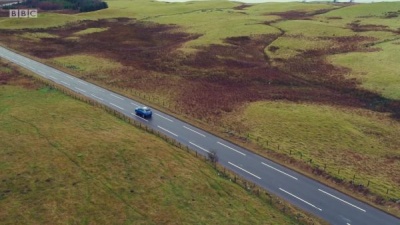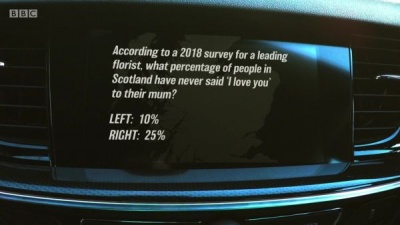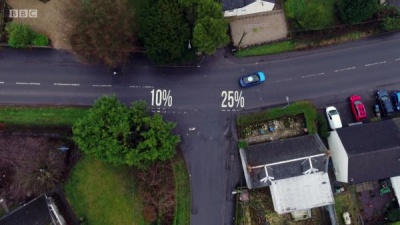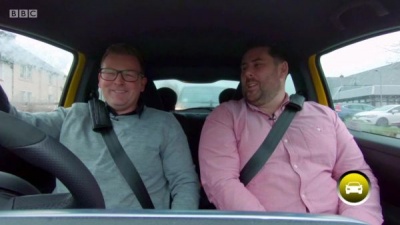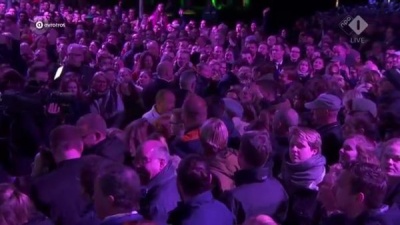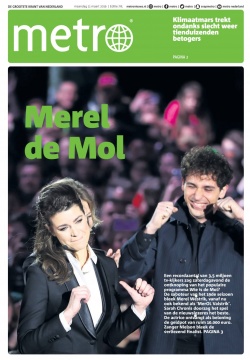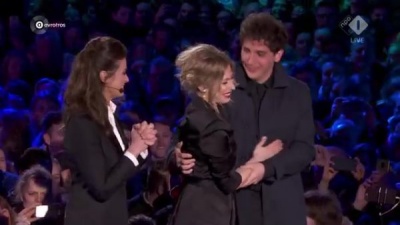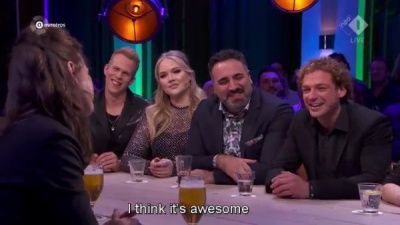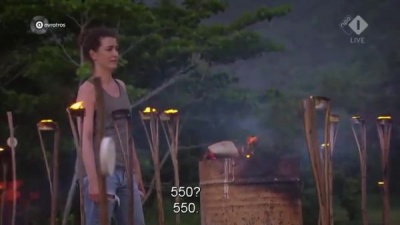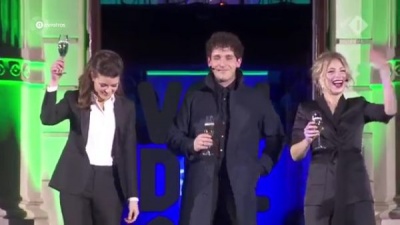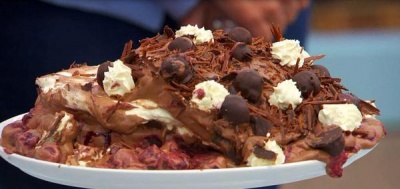Weaver's Week 2019-03-17
Last week | Weaver's Week Index | Next week
Three people enter. A winner, a loser, and a mole. But which is which? More on this story later.
Contents |
Test Drive
Bandicoot Scotland for BBC Scotland, 25 February – 7 March
Three cars are going to drive through Scotland. It's a beautiful trip, some breathtaking scenery. Mountains! Lochs! Meadows! Hedges! Wild haggis doing – actually, we can't show that before the watershed, can we?
Some of the cars are going to take longer routes. This isn't because their drivers don't know how to follow instructions from the satnav, but because their drivers don't know how to interpret instructions from the satnav.
At six key junctions, the disembodied Voice of Skippy will ask a question. The correct answer will keep the car on the shortest route. All other options will cause a detour, a longer loop adding three miles to the journey.
There's also a "pit stop" for each pair of travellers, quick-fire questions they answer in turn. One mile is deducted from their total for each correct answer. Lowest journey length – after pit-stop deductions – wins.
The heart of the show is the questions. They start as simple two-option choices. "According to a 2018 survey for a leading florist, what percentage of people in Scotland have never said 'I love you' to their mum? Turn left for 10%; turn right for 25%."
It's a question designed to generate conversation in the car. The driver and the passenger discuss their experiences, whether they'd personally said that particular phrase, or not.
We cut between the debate in all three cars (colour-coded, naturally) and eventually arrive at the question junction. We see how the cars answered, and then the right answer. Each team is also told whether they were right or wrong.
And the show continues. Another this-or-that question looms, but first we're going to see a "comedy" interlude with the voiceover and host Grado. Frankly, this brief element was the show's weak point; Grado gives a great sardonic voiceover, and explains the format well, but he can't yet do comedy skits. But we do get to see some of today's location, and meet a few people.
Later questions have three options, and some are on a roundabout with four or five choices. Researching the routes must have been a nightmare – or all routes converge near the end and they use the same roundabout for everyone.
Between some of the questions, there's a "pit stop", open-ended pub quiz questions with a one-mile discount for all the teams. Let's allow the producers some artifice. The actual length of the trip doesn't matter, only that the teams had to go down the loop and add three miles to their score. We're not bothered by the actual odometer, just rely on Grado to tell us the scores.
Lowest score – er, shortest trip – wins the cash prize of £500. Someone will win each show.
Driving Forth
All of the questions promote debate, and – with a limited number of responses – there's enough time to consider the options and weigh up the most likely. Time is limited, it might be a mile and a half from hearing the question to the junction, but that's only a few minutes' debate.
Test Drive uses a lot of surveys. In our sample episode, questions started, "According to Yougov ratings...", "According to a 2018 survey..." There were two factual question, on the sugar in food and the capacity to sweat.
We're reminded of Channel 4's The Question Jury, and not just from the questions. We only ever see the contestants in a cramped environment, the inside of their car. Even during the pit stop, the contestants remain in their seats. The cars are a "fixed rig", lots of small cameras to give a variety of angles.
The points of difference: multiple-choice questions resolve many of the slight irritations we had with The Question Jury and its woolly questions. And the tone is much lighter – one of the teams will win £500 at the end of the episode, guaranteed.
A pleasant enough show, not one we made a habit of watching, though we might seek out a celebrity version.
Wie is de Mol
AVROTROS on NPO, 5 January – 9 March
The final of Wie is de Mol is a massive cultural event. It's held in the Vondelpark, a huge green space to the south-west of Amsterdam centre. Thousands of people turn up to catch a glimpse of their favourite stars.
Across the Netherlands, cinemas show the event live, all the Molfans gather to swap theories and suspects.
There's a huge television audience, something like half the viewing eyeballs are tuned in to the announcement. It's front page news in all the popular papers; never mind the latest Brexitpanik, this is what people are talking about.
Can we put this in context? For viewers on this side of the Nordzee, it's back to 2015 and the glory days of Bake Off. Imagine that Paul and Mary had sampled the cakes from Nadiya and Andrew and Toby... and then kept their counsel. The bakers didn't go outside and learn their fate with their families, but came back six months later.
In front of a crowd of thousands in Hyde Park, and parties in cinemas, they'd review the season, bins and millefeulle and squirrels and all. And then they would announce the winner – live to the cheering crowd and the watching millions.
Now we know
We looked at Wie is de Mol last month, and suggested that Jamie or Merel were our lead suspects. Jamie went later in the series, Merel remained, and proved to be the saboteur. Let's not over-state our mole-spotting qualities: we weren't more than 30% confident until Sinan left in the penultimate week. In January, we had no idea; in March, we still had no idea.
What kept us on Merel? Lots of little things, and the main one was that we could never rule her out. The first suspicion came when she fudged her vote in the opening show's "money or exemptions" dilemma; she could see that the group was likely to go for the exemptions, so she could ask for the money and be sure not to get it.
Merel lost the challenges we'd expect a mole to lose. But she didn't care about anything played for jokers or exemptions. The mole always remains, and doesn't need bonus questions or a fast pass. Why did she take a joker in episode 2's "Waiting Rooms"? Helped to convince Nikki to stay, and that action pulled money out of the pot without adding any in.
Some of her actions were sneaky, pilfering money from everyone else's piles in the laser maze. Jamie noticed that there was only €50 for him to collect, and that suggested the mole had gone before him. This was played immediately before "Waiting Rooms"; figuring that the mole played the laser no later than Jamie, and added no money in the rooms, reduced the suspects well.
For our money, the clincher was when Merel pulled an envelope containing the two red screens. Very useful for the producers to have a double elimination, and if it's still in play when Merel made her choice, she'd pick it.
Wat gaat Merel doen?
We note that Merel wasn't active in every assignment, only in some of them. In the opening episode's dance, for instance, Merel found her partner and dropped €100 into the pot. A small price for not being suspected at the start. Many times, Merel was able to put some money in the pot, but not much – short words in the car challenge, only when Robert climbed up the tower did we get the valuable seven-letter words.
It's fair to say that Merel was helped by the group. A lot of games were sabotaged by their own uselessness – "round the churches" in week one, the escape boats challenge in mid season, and many more.
But some of her sabotages were not reflected in the broadcast. In the banana plantation, Merel removed whole bunches of bananas from view, and that couldn't be seen until this week. If there's to be a playalong factor, Wie is de Mol needs to work as a television show, and it wasn't always fair to the viewers.
Does it make for good television?
Wie is de Mol can also be watched as a spectacle in its own right. Here are ten people taking on crazy challenges. It's a flamenco party in the town square! It's a patchwork of colourful clothes! It's getting cars to parking spaces and change the letters on the roof so as to spell out words! It's ziplining through the mists! It's an elimination with nine people on nine rooftops!
Most elements need to work on television, and most weeks it felt like something was amiss. People shouting numbers on the beach and burning wood! Looks awesome, but it was just calling numbers.
A balcony game, where logic clues could have let everyone work out where they should be. There was enough information to solve it, but we needed a pen, paper, stopwatch, rewind button, and even then didn't quite work out where Robert and Niels should have been (only that they were both out of place.)
For our money, weakest challenge of the year was "Street View", finding pictures of the town you're in, dotted elsewhere in the town. It relied on information we just didn't get through the telly. But the same episode had the strongest challenge, abseil down a waterfall and identify your stick by feel alone.
This column came to Wie is de Mol expecting fireworks. Our friends have raved about the last two series, and we did expect glitter to come out of the set. It didn't happen, by common consent this year wasn't as good as the last two. This wasn't the greatest show we've seen in the still-young year (and we'll come to Y Siambr next week). Even in a down year, Wie is de Mol was interesting viewing, and we don't regret investing eleven Monday evenings to watch the show.
Countdown Update
Letters and numbers have continued to fly in the West Leeds studios, and here are the daily winners.
Dorcas Brown completed four wins, which might just prove enough to come back for finals week. David Ellis proved too strong, and won a pair himself. Dinos Sfyris then overpowered David and all before him, completing an eight-game sweep with a total of 918 points.
It's already clear that Dinos is very good; in four games he scored the maximum in 12 rounds. The luck of the cards was not with him, though. A few weeks ago, we noted how many great octochamps would never see a 150. Dinos is amongst their number, he could not have scored more than 146 with any set of selections.
John Ashcroft took over the vacant chair, and looked set for a decent run. But he ran into Maggie Barlow, who is now seven games unbeaten and goes for the octochamp on Monday. Maggie is a very good player, retired librarians have a tradition with words, but Dinos might be favoured in a head-to-head match.
Amongst those defeated were Daniel "Dinny" Corcoran. He's another footballer, playing for Bohemians FC in the League of Ireland. As he didn't win a game, he might have to be on the subs' bench for the Countdown First IX alongside game winners Clarke Carlisle and Matt Le Tissier.
This Week and Next
Channel 4 say they have signed a new deal with Love Productions for Bake Off, it'll still be flying around the blocks until 2021. The deal also includes Junior Bake Off, slated for later this year.
Second Take: last week's Week mis-stated Alex Trebek's disease. It's cancer of the pancreas, not the colon. That'll teach us to skim-read articles.
BARB ratings in the week to 3 March.
- Call the Midwife is still the most popular show of all (BBC1, Sun, 9.1m). Dancing on Ice remains the top game in its semi-final week (ITV, Sun, 5.75m).
- Next come Masterchef (BBC1, Thu, 5.05m) and The Voice (ITV, Sat, 4.85m). The Chase (ITV, Fri, 4m) beats Pointless Celebrities (BBC1, Sat, 3.85m).
- Sewing Bee (BBC2, Tue, 3.65m) managed to beat out All Together Now (BBC1, Sat, 3.45m). Brightest Family (ITV, Wed, 2.85m) and Tipping Point (ITV, Fri, 2.7m) all beat Small Fortune (ITV, Sat, 2.45m); !mpossible Celebrities was only just behind (BBC1, Sat, 2.4m).
- Only Connect (BBC2, Mon, 2.37m) continues just ahead of University Challenge (BBC2, Mon, 2.33m). Race Across the World bowed with 1.95m (BBC2, Sun).
- Outside the top five channels, the game leaders are Coach Trip (E4, Thu, 450,000), Portrait Artist (pay-tv channel Artsworld, Tue, 410,000), and repeats of Have I Got a Bit More News for You (Dave, Sun, 345,000).
- S4C had a big week of shows. Annual song contest Can i Gymru (Fri, 25,000) had its 50th birthday marked by documentary Dathlu'r 50 (Thu, 20,000). The choir contest Cor Cymru returned (Sun, 17,000), and dividing quiz Rhannu made the upper echelons (Wed, 13,000). The anglophone version of Project Z launched on CITV (Wed, 99,000).
Some old friends are back. A primetime promotion for Great Local Menu (BBC2, from Wed), conveniently scheduled to avoid Masterchef on BBC1. Celebrity Juice starts a new series (ITV2, Thu).
Pointless has a set of bloopers (BBC1, Sat) and tempts people to watch Catchpoint (BBC1, Sat). And what's Dara Ó Briain hosting? That's Blockbusters (Comedy Central, Thu).
Photo credits: Merel Westrik / Instagram, Bandicoot Scotland, AVROTROS, Metronieuws, YTV, Love Productions.
To have Weaver's Week emailed to you on publication day, receive our exclusive TV roundup of the game shows in the week ahead, and chat to other ukgameshows.com readers, sign up to our Yahoo! Group.



